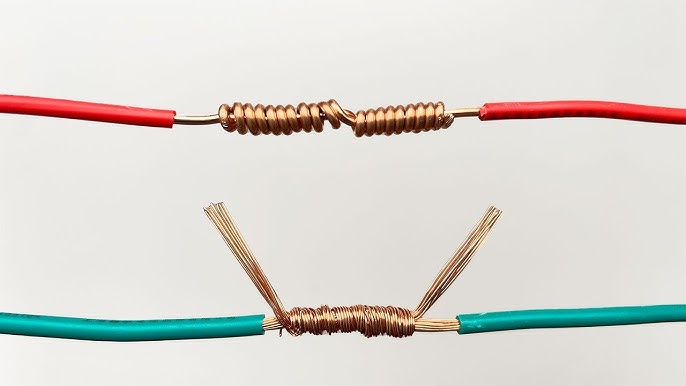Quick Answer: Whether you should twist wires before crimping depends entirely on your connector type and wire gauge. For most crimp connectors, you should NOT twist stranded wires before crimping, as this can reduce contact surface area and connection reliability. However, twisted pairs in data cables and some specific applications do require pre-twisting.
Understanding proper wire preparation for crimping is crucial for creating safe, reliable electrical connections that meet code requirements and prevent costly failures. This comprehensive guide covers everything you need to know about wire twisting, crimping techniques, and professional best practices.
What Does “Twisting Wires Before Crimping” Mean?

Wire twisting refers to the practice of rotating individual stranded wire conductors together before inserting them into a crimp connector. This technique consolidates the wire strands into a more compact, unified bundle.
Two main scenarios involve wire twisting:
- Individual wire strand twisting: Rotating strands of a single conductor together
- Multiple wire twisting: Joining two or more separate wires by twisting them together
The critical distinction is that these scenarios require completely different approaches and have different safety implications.
Key Differences: When to Twist vs. When NOT to Twist
| Connection Type | Twist Wires? | Reason | Code Compliance |
|---|---|---|---|
| Standard Crimp Terminals | NO | Reduces contact surface area | NEC 110.14(A) |
| Butt Splice Connectors | NO | Crimping mechanism designed for untwisted strands | UL 486A/B |
| Ring/Spade Terminals | NO | Maximum surface contact needed | NEC Article 110 |
| Twisted Pair Data Cables | YES | Maintains signal integrity | TIA-568 Standards |
| Wire Nuts (Before Crimping) | YES | Required for proper mechanical connection | NEC 110.14(B) |
| Ferrule Connectors | NO | Designed for organized strand insertion | IEC 60947-7-4 |
The Science Behind Proper Crimping Technique
Why Most Crimps Don’t Require Twisting
Modern crimp connectors are engineered to work with untwisted stranded wire for several technical reasons:
Contact Surface Maximization: Untwisted strands create more contact points with the connector’s internal surfaces, improving conductivity and reducing resistance.
Even Pressure Distribution: Crimping tools are designed to compress strands evenly when they’re arranged naturally, not twisted into a compact bundle.
Cold Welding Effect: The crimping process creates microscopic welds between wire strands and connector material—this works best with maximum surface exposure.
When Twisting Is Actually Required
Data and Communications Cables: Twisted pairs maintain specific impedance characteristics and reduce electromagnetic interference.
Pre-Assembly for Wire Nuts: Before applying wire nuts, codes require twisting to ensure proper mechanical connection.
Multi-Wire Splices: When joining multiple wires in a single connector, controlled twisting may be necessary for proper fit.
Step-by-Step Crimping Process for Different Wire Types
For Standard Electrical Connections (DO NOT Twist)
- Strip Wire to Proper Length
- Use wire strippers calibrated to your wire gauge
- Strip only enough insulation to reach the connector barrel
- Avoid nicking or cutting individual strands
- Inspect Wire Strands
- Ensure all strands are intact and undamaged
- Remove any frayed or broken strands
- Keep strands naturally arranged, not twisted
- Insert Wire into Connector
- Push wire fully into connector barrel
- Ensure no strands extend beyond the crimp zone
- Verify insulation doesn’t enter the crimp area
- Apply Crimp with Proper Tool
- Use calibrated crimping tool appropriate for connector type
- Apply full compression in one smooth motion
- Check for proper crimp depth and formation
For Twisted Pair Applications (Controlled Twisting Required)
- Maintain Existing Twist Rate
- Preserve factory twist characteristics in data cables
- Don’t add additional twisting beyond specifications
- Follow TIA-568 standards for untwist length (typically ½ inch maximum)
- Prepare Individual Wires
- Strip to exact length specified by connector manufacturer
- Keep twist intact until final insertion
- Arrange pairs according to wiring standard (T568A or T568B)
Professional Selection Criteria: Choosing the Right Approach
Factors That Determine Twisting Requirements
Connector Design Analysis:
- Examine connector internal structure
- Check manufacturer specifications
- Verify intended wire preparation method
Application Environment:
- High-vibration applications may require different techniques
- Temperature extremes affect connector performance
- Moisture exposure influences connection longevity
Electrical Requirements:
- Current capacity needs
- Voltage rating compliance
- Impedance matching for data applications
Wire Gauge Considerations
| Wire Gauge (AWG) | Typical Application | Twisting Recommendation | Notes |
|---|---|---|---|
| 22-16 AWG | Low-voltage electronics | Usually NO twisting | Follow connector specs |
| 14-12 AWG | Household circuits | NO twisting for crimps | Twist only for wire nuts |
| 10-8 AWG | Heavy appliances | NO twisting | Use heavy-duty crimps |
| 6 AWG and larger | Service entrances | Professional installation | Specialized techniques |
Safety Warnings and Code Compliance
⚠️ CRITICAL SAFETY NOTICE: Improper crimping techniques can cause electrical fires, equipment damage, and personal injury. Always follow manufacturer specifications and local electrical codes.
National Electrical Code (NEC) Requirements
NEC 110.14(A) mandates that electrical connections be made with listed devices and proper installation methods. This includes:
- Using connectors rated for specific wire types and gauges
- Following manufacturer installation instructions exactly
- Ensuring connections can carry expected current loads safely
NEC 110.3(B) requires that listed equipment be installed according to manufacturer instructions, which typically specify whether twisting is required or prohibited.
Professional Installation Standards
When to Call a Professional:
- Service panel connections
- High-voltage applications (over 600V)
- Commercial or industrial installations
- Any work requiring permits or inspections
DIY Safety Limits:
- Stick to low-voltage electronics and automotive applications
- Never work on live circuits
- Use only properly rated tools and connectors
- Verify connections with appropriate testing equipment
Common Mistakes and Troubleshooting
Top Crimping Errors to Avoid
Over-twisting Stranded Wire: Creates stress concentrations and reduces contact area in standard crimp connections.
Using Wrong Tool Size: Improper crimp tool settings lead to loose or over-compressed connections.
Inadequate Strip Length: Too little exposed wire prevents proper connection; too much creates safety hazards.
Mixed Wire Types: Combining solid and stranded wire in single connectors without proper technique.
Troubleshooting Poor Connections
Connection Pulls Apart: Usually indicates insufficient crimp compression or improper wire preparation.
High Resistance Reading: May result from twisted wires in connectors designed for untwisted strands.
Intermittent Connection: Often caused by over-twisting causing stress on individual strands.
Expert Tips for Professional Results
💡 Pro Tip: Use a crimp pull tester to verify connection strength. Properly crimped connections should withstand specified pull forces without separation.
💡 Pro Tip: For data cables, use a cable certifier to verify that your crimping technique maintains proper electrical characteristics.
💡 Pro Tip: Keep a crimp height gauge handy to ensure consistent compression across all connections.
Tool Selection for Best Results
Essential Crimping Tools:
- Ratcheting crimp tool (prevents under-crimping)
- Wire strippers with gauge markings
- Cable testers for verification
- Crimp height gauge for quality control
Quality Indicators:
- Tools with adjustable dies
- Ergonomic handles for repetitive use
- Clear markings for wire gauge selection
- Positive ratcheting action
Quick Reference Guide
Decision Matrix: To Twist or Not to Twist
NEVER Twist For:
- ✗ Standard electrical crimp terminals
- ✗ Automotive electrical connections
- ✗ Ferrule-style connectors
- ✗ Most electronic component connections
ALWAYS Twist For:
- ✓ Wire nut installations (before applying nut)
- ✓ Maintaining twisted pair integrity in data cables
- ✓ Multi-wire splices in appropriate connectors
- ✓ When manufacturer explicitly requires it
Check Specifications For:
- ⚠️ Industrial control applications
- ⚠️ High-frequency signal connections
- ⚠️ Custom connector systems
- ⚠️ International standard compliance
Frequently Asked Questions
Does twisting wires make the connection stronger?
For most crimp connections, twisting actually makes the connection weaker and less reliable. Crimp connectors are designed to maximize contact with untwisted strands. However, for wire nut connections, twisting is required by electrical code for proper mechanical connection before applying the nut.
What happens if I twist wires when I shouldn’t?
Twisting stranded wire before crimping reduces the contact surface area between wire and connector, potentially causing higher resistance, heat buildup, and connection failure. It can also make it difficult to insert the wire fully into the connector barrel.
How do I know if my connector requires twisted or untwisted wire?
Always consult the manufacturer’s installation instructions. Most crimp-style connectors work with untwisted strands, while wire nuts require pre-twisting. When in doubt, contact the manufacturer or consult with a qualified electrician.
Can I use the same technique for all wire gauges?
No. Different wire gauges may have different requirements even with the same connector type. Larger gauge wires are typically more rigid and may require different preparation techniques. Always verify specifications for your specific wire gauge.
What tools do I need for proper wire preparation?
Essential tools include properly calibrated wire strippers, appropriate crimping tools, and testing equipment to verify connections. For data cables, you’ll also need tools that maintain twist integrity during preparation.
How can I test if my crimp connection is good?
Use a gentle pull test to verify mechanical strength, measure resistance with a multimeter to check electrical integrity, and visually inspect for proper crimp formation. For data cables, use a cable certifier to verify signal characteristics.
Are there different standards for residential vs. commercial work?
Yes. Commercial and industrial applications often have stricter requirements and may require different techniques or certified installers. Always check local codes and applicable standards like NEC, UL, or industry-specific requirements.
What’s the difference between crimp-style and other connector types?
Crimp connectors create connections through mechanical compression, while other types like wire nuts rely on twisted wire mechanical connections, and solderable connections use metallurgical bonding. Each type has specific wire preparation requirements.
Conclusion: Making the Right Connection Choice
The decision to twist or not twist wires before crimping depends entirely on your specific connector type, wire gauge, and application requirements. For the vast majority of crimp-style electrical connections, you should NOT twist stranded wire, as this reduces connection quality and reliability.
Key Takeaways:
- Most crimp connectors work best with untwisted stranded wire
- Data cables require maintaining existing twist characteristics
- Wire nuts need pre-twisted connections per electrical code
- Always follow manufacturer specifications and local electrical codes
- When in doubt, consult with qualified professionals
By following these professional guidelines and safety practices, you’ll create reliable, code-compliant electrical connections that provide years of safe service. Remember that proper technique is essential not just for performance, but for safety and compliance with electrical standards.
Ready to Start Your Project? Ensure you have the right tools, proper connectors, and clear understanding of your specific application requirements before beginning any electrical work. When working with household electrical systems or commercial applications, consider consulting with a licensed electrician to ensure safety and code compliance.

